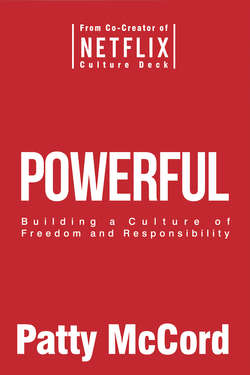Читать книгу Powerful - Patty McCord - Страница 15
На сайте Литреса книга снята с продажи.
People Don’t Want to Be Entertained at Work; They Want to Learn
ОглавлениеWhen I was at Sun we had 370 people in HR. 370 people! And virtually all of them were divorced from the business; they couldn’t tell you what we made. We were doing initiatives and off-sites and celebrations. We were half entertainment and half happy-face HR. It was really fun but somehow empty. We always wanted more respect and recognition.
I became jazzed about my work in a new way when I became integrally involved in growing the company at Netflix. When I accepted the job, it was on the condition that I would not be siloed off as the HR lady; I would report directly to Reed and be part of the executive team. That meant that I had to step up and learn deeply about how the business worked. As I did that, I came to understand the enormous value of every single employee at the company gaining the same understanding. Reed and I had both been inspired by the argument for open-book management in Jack Stack and Bo Burlingham’s book The Great Game of Business. The importance of transparency was driven home for me by our dramatic shift from the DVD-by-mail model to the subscription model.
One morning when Reed and I were carpooling to work, he started passionately talking about changing from a pay-per-rental service to a subscription model, getting all fired up about it. I told him, “Okay, all right! I can hear it in your voice. I know what happens when you get like this. You are sure you’re right about this, aren’t you?” I knew that most employees weren’t going to like the change, but I also knew that Reed was going to do it anyway because he believed it was the right thing for the business. It was clear that the change would be wrenching. It involved much more than simply changing the terms on the website; we had to change the shipping model and the billing model and the whole structure of the company, its departments and supervisors and salespeople. We also had to bring in lots of new people who could build up our technical capabilities for serving subscribers and making good use of the tsunami of user data we’d be accumulating, and we were facing intense competition for them from our biggest competitor, which was a hundred times bigger than we were: Blockbuster.
The beautiful thing for me was that because the shift in the business was so dramatic, I had to focus very intensively on two things. First, I had to deeply understand the new business model and what was at stake. Subscription is a numbers race, and revenue occurs only over time after an up-front investment. I appreciated what a very big bet it was. We’d have to spend considerable money to sign up a first group of subscribers, which was an investment in getting more customers, and those new customers would allow us to pay for the next expansion. This is the fundamental Netflix model; pay up front for benefits in future years. At this stage in our growth, that considerable up-front expense meant that we didn’t have much time to make the model work. Second, the urgency of getting it right meant that I had to help everyone else in the company understand the new business model too. At the time, the only model any of us knew included due dates and late fees. When Reed proposed a subscription without due dates and late fees, it was truly scary. After all, late fees were the gas in Blockbuster’s engine. When we said weren’t going to charge them, everybody in the company was asking, “How’s that going to work?”
I fell in love with being a businessperson, and I didn’t want to be happy-face HR den mother anymore. I also fell in love with explaining very clearly and fully to everyone in the company why we were making the decisions we were, how they could best participate in achieving our goals, and what the obstacles would be.
My aha moment reminded me of when my son was six and playing soccer. My husband was the coach, and I’d go to lots of the practices. Watching the kids was hysterical. They’d just clump around the ball. I asked my husband in the car on the way to the team’s first game, “So what’s your strategy for the game?” He said, “Well, I was going to really attempt to have everybody moving down the field in the same direction at the same time.” I responded, “You know, I think that’s achievable,” and he said, “Well, but in the second half, they’ve got to go the other way.” The World Cup fell later in the season, and I had the kids over to watch. When they saw the view of the game from the blimp, they realized, Oh! That’s what a pass looks like! Business is no different.
People need to see the view from the C suite in order to feel truly connected to the problem solving that must be done at all levels and on all teams, so that the company is spotting issues and opportunities in every corner of the business and effectively acting on them. The irony is that companies have invested so much in training programs of all sorts and spent so much time and effort to incentivize and measure performance, but they’ve failed to actually explain to all of their employees how their business runs.
